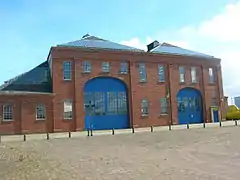Scottish Maritime Museum
The Scottish Maritime Museum is an industrial museum with a Collection Recognised as Nationally Significant to Scotland.[1] It is located at two sites in the West of Scotland in Irvine and Dumbarton, with a focus on Scotland's shipbuilding heritage.


Irvine - The Linthouse


The museum's Linthouse building is located at Irvine Harbour, situated within the category A listed former Engine Shop of Alexander Stephen and Sons, which was salvaged and relocated from their derelict Linthouse shipyard in Glasgow in 1991.[2] The Linthouse engineering shop is now home a collection of significant vessels including MV Kyles[3] and MV Spartan[4] which are listed on the National Historic Ships UK register. A highly significant vessel built of iron in 1872 in Paisley, MV Kyles is the oldest iron Clyde built vessel still afloat in the UK.[5] The museum also has a collection of marine engines and industrial machine tools, and owns a recreated 1920s worker's tenement flat at Irvine Harbour. The museum also has a significant collection of artwork funded by the Heritage Lottery Fund.[6]

Looking seaward towards the museum's pontoons, with the closed 'Big Idea' building and footbridge in the background 
The Scottish Maritime Museum with the old ICI Explosives tug MV Garnock to the right 
The ship exhibits at the pontoons 
The Clyde Puffer MV Spartan at the slipway 
The Linthouse Engine building from the front
Dumbarton - Denny Ship Model Experiment Tank
The Denny Ship Model Experiment Tank, in Dumbarton, focuses on the world of the naval architect. Shipbuilder William Denny Jr of William Denny and Brothers was inspired by the work of eminent naval architect William Froude and completed the tank for his shipyard in 1883. It was the world's first commercial example of a ship testing tank. Re-opened as a museum in 1982, it retains many of its original features, including the original 100-meter-long tank. The museum also tells the story of the test tank's original owners, William Denny and Brothers of Dumbarton, one of the most innovative shipbuilding companies in the world until their closure in 1963.
Trust Structure
The museum is an independent museum operated by a charitable trust: the Scottish Maritime Museum Trust. It became operational in 1983.[7] The first trust chairperson was Clydeside shipbuilder Ross Belch who held the post until 1998[8] The trust includes Scottish industrial historian John R. Hume among its trustees.[9] The founding Director was Dr Henry C. McMurray.[10]
Locations
- Dumbarton: 55.94342°N 4.56312°W
- Irvine: 55.60953°N 4.67684°W
See also
Notes
- "Scotland has 47 Recognised Collections of National Significance". Museum Galleries Scotland. Retrieved 20 August 2018.
- Historic Environment Scotland. "Gottries Road, Linthouse Building, Scottish Maritime Museum (Category A Listed Building) (LB35450)". Retrieved 28 March 2019.
- "Kyles | National Historic Ships". www.nationalhistoricships.org.uk. Retrieved 20 August 2018.
- "Spartan | National Historic Ships". www.nationalhistoricships.org.uk. Retrieved 20 August 2018.
- "Clydebuilt, Braehead". Scottish Maritime Museum. Retrieved 5 April 2010.
- "Scottish Maritime Museum | Art UK". artuk.org. Retrieved 20 August 2018.
- Dr Henry C McMurray, BA, MSc, Eon, OBE entry in Trustee list of the SS Great Britain confirms 1983 date, retrieved 22 July 2013.
- Glasgow Herald obituary to Sir Ross Belch of 27 March 1999 retrieved 22 July 2013 confirms his role.
- Who's who in the Museums and Attractions Partnership retrieved 22 July 2013.
- Trustees of the SS Great Britain retrieved 22 July 2013.
Further reading
- Douglas McGowan, Clydebuilt: A Photographic Legacy, 2005, Tempus Publishing, ISBN 0-7524-3228-1
- John Shields, Clyde Built: A History of Shipbuilding on the River Clyde, 1949, William MacLellan